Global Lime Market Forecast
- Lime market size to reach from US$46.3 Bn (2022) to US$59.6 Bn by the end of 2030
- Global lime market size poised to see 3.2% CAGR between 2023 and 2030
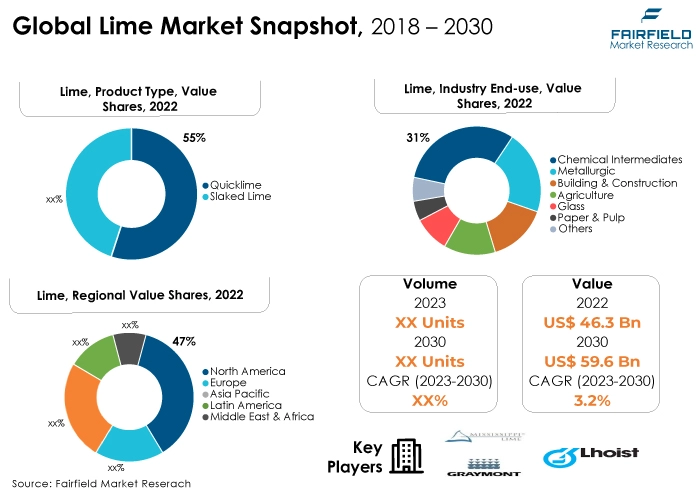
Major Report Findings - Fairfield's Perspective
- The key trend anticipated to fuel the growth of lime market is the increasing demand from the construction industry.
- Another major market trend expected to fuel the growth is the lime market, a rapidly expanding global agriculture industry. The market is also predicted to profit from the growing worldwide agriculture industry.
- The lime market is driven by chemical intermediates such as lime, specifically quicklime and slaked. Lime is a fundamental raw material in the production of various mediators used in a wide range of industrial processes, making it a pivotal component in the chemical industry's supply chain.
- Quicklime is experiencing growth due to its rapid reactivity and versatility. It is vital in applications like construction, steel manufacturing, and flue gas desulfurisation. Quicklime's ability to quickly adjust pH levels and neutralise pollutants drives its increasing demand in various industries, contributing to its growth.
- Chemical intermediates capture the largest market share in the lime market because Lime, particularly quicklime and slaked lime, is an essential raw material in the production of various mediators used in diverse industrial processes, including chemicals, textiles, and metallurgy. Its versatile role makes it a dominant player in this segment.
- North America leads the lime market due to robust construction and industrial sectors, stringent environmental regulations necessitating lime use, and a thriving agriculture industry. The region's diverse applications and focus on sustainability contribute to its dominant market position.
- Asia Pacific is experiencing the highest CAGR in the lime market due to rapid urbanisation, infrastructure development, and increasing agricultural activities. These factors drive strong demand for construction materials, environmental control solutions, and soil improvement, making the region a high-growth market for lime products.
- Price volatility poses a challenge to the lime market due to fluctuations in energy and transportation costs, impacting production and distribution expenses. Such unpredictability can affect profitability for both producers and consumers, necessitating strategies to manage and mitigate these price swings effectively.
A Look Back and a Look Forward - Comparative Analysis
The lime market is growing due to its versatile applications in construction, environmental control, agriculture, and industry. Increasing construction projects, ecological regulations requiring emission control, and the need for soil improvement in agriculture are driving demand. Lime's role in sustainable construction materials and its contribution to addressing environmental challenges further boosts its growth in the market.
The market witnessed staggered growth during the historical period 2018 - 2022. This is due to the substantial growth of the major end-use application sectors such as construction and agriculture. The construction sector is a key driver of the lime market due to its extensive use of lime-based materials, including mortar, concrete, and plaster.
Lime enhances the durability and workability of construction materials, making them essential for building infrastructure residential, and commercial projects. The global construction boom, driven by urbanisation and infrastructure development, significantly fuels the demand for Lime, making the construction sector a dominant force in the lime market.
The prospects for the lime market are promising. It is anticipated to continue growing due to increasing urbanisation, infrastructure development, and environmental regulations. Lime's role in sustainable construction materials and emission control technologies positions it favourably for further expansion. Additionally, growing awareness of soil improvement's importance in agriculture and its contribution to food security ensures a positive outlook for the lime market.
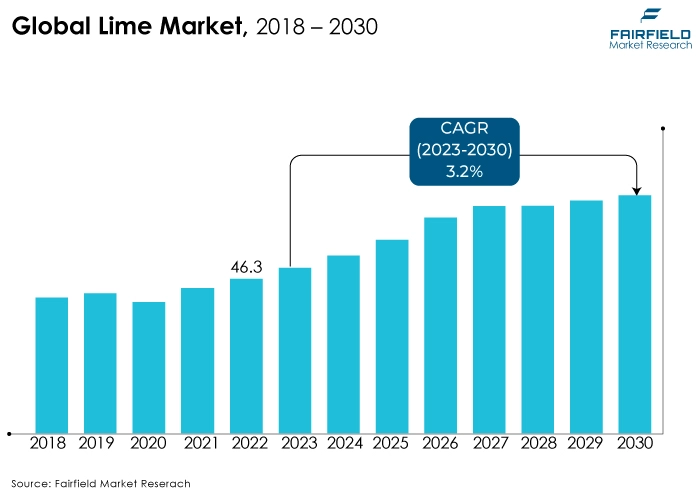
Key Growth Determinants
- Pacing Construction Projects, and Infrastructural Developments
Construction and infrastructure development play a pivotal role in driving the lime market's growth. Lime is a fundamental component in construction materials like mortar, plaster, and concrete, essential for building roads, bridges, buildings, and other infrastructure projects. As urbanisation trends and population growth continue, the demand for construction materials, and subsequently, lime, remains strong.
Lime's ability to provide durability, strength, and long-lasting properties to construction materials makes it indispensable in the industry. Additionally, lime is used in soil stabilisation for foundations, reducing settlement, and enhancing the load-bearing capacity of soil, all critical aspects of construction projects.
With increased investments in infrastructure, particularly in emerging economies, the construction sector's expansion is expected to drive sustained demand for lime in the foreseeable future, positioning it as a vital player in the global construction and development landscape.
- Growing Environment Remediation
Environmental remediation drives the lime market as Lime is used to treat contaminated soils and mitigate hazardous waste sites. Lime's unique ability to stabilise heavy metals, neutralise acidic soils, and immobilise contaminants makes it a valuable tool in soil remediation efforts.
As awareness of environmental issues and regulations concerning contaminated sites grows, the demand for Lime in ecological cleanup projects increases. This positions lime as a crucial component in sustainable solutions for addressing soil pollution, contributing to the market's growth.
- Growing Innovations to Drive Market Growth
Innovations in lime products are propelling the lime market forward by expanding its range of applications and enhancing product performance. These innovations include the development of specialty lime products tailored to specific industry needs, such as high-purity lime for water treatment and advanced lime formulations for construction materials.
Additionally, research into more efficient production processes and sustainable sourcing methods is making Lime a more environmentally friendly choice. These innovations not only meet evolving industry requirements but also unlock new market segments, driving the overall growth and adoption of lime-based solutions.
Major Growth Barriers
- Growing Stringency of Environment Regulations
Increasing environmental regulations challenge the lime market by imposing stringent emission standards and compliance requirements on industries that rely on lime for processes like flue gas desulfurisation. Meeting these regulations often requires substantial investments in pollution control technologies, raising operational costs.
Furthermore, regulations may drive a shift toward cleaner alternatives, reducing demand for lime in certain applications. As environmental concerns continue to grow, lime producers must navigate evolving regulatory landscapes to maintain competitiveness while minimising their ecological impact, posing a significant challenge to the industry.
- Price Volatility
Price volatility presents a challenge to the lime market due to factors like energy costs and transportation expenses, which influence lime production and distribution costs. These fluctuations can affect the profitability of lime producers and create uncertainty for consumers.
Sudden price spikes may also impact budget planning for industries reliant on lime, such as construction and water treatment. Managing and mitigating price volatility is essential for both suppliers and users of lime to ensure cost-effective and stable operations in the market.
Key Trends and Opportunities to Look at
- Advanced Production Techniques
Advanced production techniques in the lime market encompass innovations in kiln design, automation, and process control. These techniques aim to enhance energy efficiency, reduce emissions, and improve product quality.
High-efficiency kilns and sophisticated control systems allow lime producers to optimise production processes, minimise environmental impact, and meet evolving industry standards, making lime production more sustainable and cost-effective.
- Carbon Capture and Utilisation (CCU)
Carbon capture and utilisation (CCU) technologies in the lime market focus on capturing carbon dioxide (CO2) emissions from lime production and converting them into valuable products. This approach mitigates the environmental impact of lime production while creating economic opportunities.
CCU can involve utilising captured CO2 in chemical processes, carbonation reactions, or even storing CO2 safely underground, aligning with carbon reduction and sustainability goals in the lime industry.
- Alternative Fuel Sources
Alternative fuel sources are gaining traction in the lime market as producers seek to reduce greenhouse gas emissions and dependence on traditional fossil fuels. Biomass, waste-derived fuels, and other sustainable alternatives are being explored to power lime kilns. These sources not only lower environmental impact but also promote energy efficiency, aligning with the industry's commitment to sustainable and eco-friendly practices.
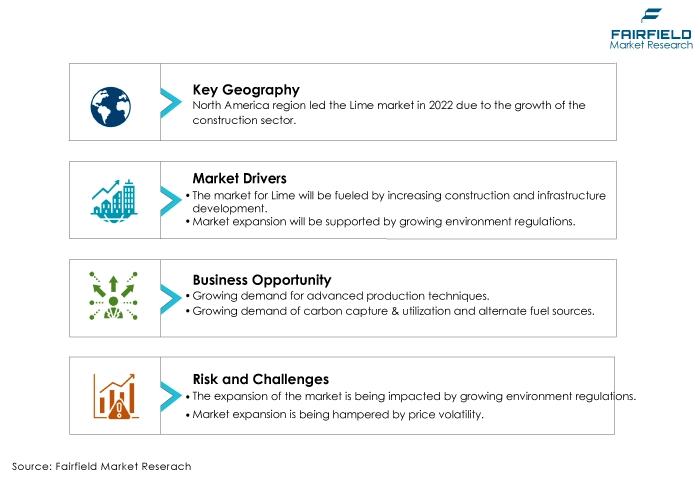
How Does the Regulatory Scenario Shape this Industry?
The regulatory scenario exerts a profound influence on the lime market, shaping its production practices, environmental impact, and market dynamics. Environmental regulations, such as emissions limits and pollution control requirements, are central to lime production. Compliance with these standards necessitates substantial investments in emission-reducing technologies and process optimisation to minimise the environmental footprint.
As governments worldwide intensify their focus on reducing industrial emissions and promoting sustainable practices, lime producers are compelled to adapt, often leading to more eco-friendly and efficient production processes. Furthermore, regulatory bodies often establish stringent product quality standards for lime, ensuring it meets specific purity and chemical composition criteria. These quality standards are critical for various industries, including construction and water treatment, which rely on consistent and reliable lime products.
Regulatory oversight fosters consumer confidence by guaranteeing that lime products are safe and suitable for their intended applications. Moreover, regulations extend to land use and permitting for limestone quarrying and lime production sites. Stringent requirements for responsible land management and reclamation practices aim to minimise ecological disruption and promote the restoration of quarry sites.
Compliance with these regulations underscores the lime industry's commitment to sustainable and ethical practices, aligning with broader environmental and societal goals. In essence, the regulatory landscape shapes the lime market by emphasizing environmental responsibility, product quality, and sustainability, ultimately driving the industry toward more eco-friendly and responsible practices.
Fairfield’s Ranking Board
Top Segments
- Quicklime Maintains Dominance
Quicklime, or calcium oxide (CaO), has captured the largest market share in the lime industry due to its versatility and widespread use. It serves as a fundamental raw material in various sectors, including construction, steel manufacturing, water treatment, and agriculture. Quicklime's ability to react quickly with water, making it a vital component in applications like mortar and pH control in water treatment, has solidified its dominance.
Additionally, its role in environmental solutions like flue gas desulfurisation further contributes to its significant market share. Slaked lime, or calcium hydroxide (Ca(OH)2), is anticipated to have the highest CAGR in the lime market due to its expanding applications in various sectors.
Slaked Lime is preferred in industries like water treatment for its exceptional ability to adjust pH levels, treat drinking water, and neutralise acidic effluents. It is also gaining traction in the construction sector for its role in soil stabilisation and as a building material. Moreover, its use in food processing, pharmaceuticals, and chemical manufacturing is driving its growth as these industries expand and prioritise sustainability.
- Chemical Intermediates Continue to Lead
Chemical intermediates have secured the largest market share in the lime market due to their pivotal role in diverse industrial processes. Lime, particularly quicklime (CaO) and slaked Lime (Ca(OH)2), is used as a key chemical reactant in the production of various intermediates, such as calcium-based salts and compounds. These intermediates find applications in a wide range of industries, including chemicals, textiles, and metallurgy.
The versatility of Lime as a precursor in chemical synthesis processes and its contributions to multiple value chains have led to its dominant position in this segment. Agriculture is experiencing the fastest CAGR in the lime market due to its critical role in soil health and crop productivity. Lime, particularly agricultural lime or aglime, is used to correct soil acidity and improve nutrient uptake by plants.
As global food demand rises, farmers increasingly recognise the importance of soil amendment with Lime to enhance yields and ensure sustainable agriculture. This growing awareness, coupled with government support and adoption of modern farming practices, is propelling the agricultural segment's rapid expansion in the lime market.
Regional Frontrunners
North America at the Forefront
North America has captured the largest market share in the lime industry due to several key factors. Firstly, the region boasts a robust construction sector driven by residential, commercial, and infrastructure projects, all of which require lime-based materials like concrete and mortar.
Stringent environmental regulations have led to increased lime consumption in flue gas desulfurisation systems, a crucial component in reducing emissions from power plants. Additionally, the agriculture sector benefits from lime applications to enhance soil quality and boost crop yields, contributing to significant lime demand.
The region's industrial base, including steel production and mining, relies on lime for various processes. These factors, coupled with a strong focus on sustainability and product quality, have solidified North America's position as the leading market for lime products.
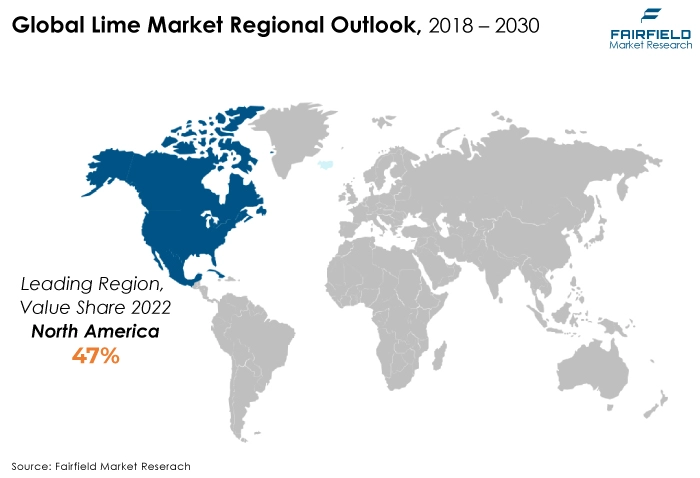
Asia Pacific All Set for an Exceptional Pace of Growth
Asia Pacific will be experiencing the fastest CAGR in terms of value in the lime market due to several compelling factors. Rapid urbanisation, population growth, and infrastructure development in countries like China, and India are driving increased demand for construction materials like lime-based products.
Moreover, the agriculture sector is expanding to meet the food needs of growing populations, leading to rising lime usage for soil improvement. Additionally, industrial growth, including steel production and water treatment, relies heavily on lime.
The region's evolving regulatory environment, coupled with efforts to promote sustainability, further fuel lime market growth, making Asia Pacific a dynamic and high-growth market for lime products.
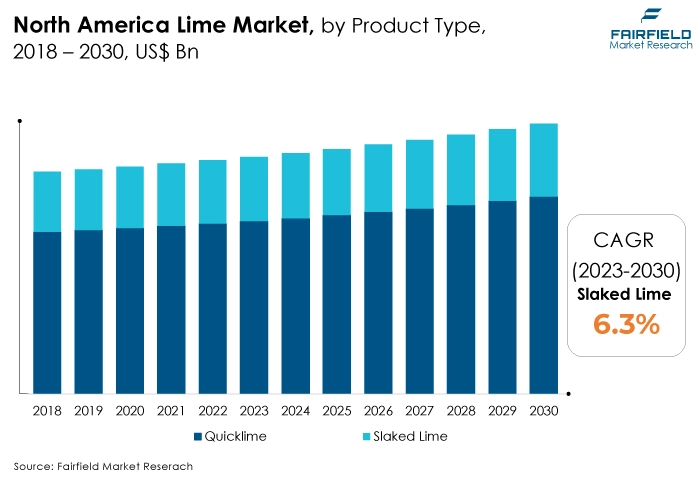
Fairfield’s Competitive Landscape Analysis
The global lime market is consolidated, with fewer major players present globally. The key players are introducing new products and working on the distribution channels to enhance their worldwide presence. Moreover, Fairfield Market Research expects more consolidation over the coming years.
Who are the Leaders in the Global Lime space?
- Lhoist Group
- Graymont
- Mississippi Lime Company
- Carmeuse
- United States Lime & Minerals
- HID Global
- Minerals Technologies
- Nordkalk Corporation
- Pete Lien & sons
- Linwood Mining & Minerals Corporation
- Valley Minerals
- Sigma Minerals
- Cheney Lime & Cement Company
- Chememan Co
- Atlantic Minerals Limited
Key Company Developments
New Product Launch
- October 2022: The lime market is driven by chemical intermediates as Lime, specifically quicklime and slaked Lime, is a fundamental raw material in the production of various mediators used in a wide range of industrial processes, making it a pivotal component in the chemical industry's supply chain.
Distribution Agreement
- October 2021: The lime market is driven by chemical intermediates as Lime, specifically quicklime and slaked Lime, is a fundamental raw material in the production of various mediators used in a wide range of industrial processes, making it a pivotal component in the chemical industry's supply chain.
An Expert’s Eye
Demand and Future Growth
As per Fairfield’s Analysis, growth in metal is driving the market. The lime market continues to experience strong market demand driven by growth in construction, environmental regulations, and agriculture. Future growth prospects are promising as industries seek sustainable solutions, innovative applications, and eco-friendly practices.
The market is poised to expand further, driven by increasing urbanisation, infrastructure development, and a focus on soil improvement for food security. Additionally, Lime's role in emission control technologies and sustainable construction materials positions it favorably for growth, aligning with global sustainability goals and ensuring a bright future for the lime market.
Supply Side of the Market
Leading countries in the lime market include China, the United States, India, Brazil, Mexico, and Germany. These nations are prominent due to their substantial lime production and consumption driven by sectors such as construction, agriculture, steel production, and environmental control. Their economic activities and infrastructural development contribute significantly to the global lime market's growth and dynamics.
The primary raw material for lime production is limestone (calcium carbonate), which is typically sourced from quarries. Limestone is heated in kilns to produce lime products. Other raw materials may include clay, shale, or silica.
Major suppliers of limestone and raw materials for the lime market vary by region, but some prominent global suppliers retain LafargeHolcim, CEMEX, HeidelbergCement, and Vulcan Materials Company. These companies have extensive quarry operations and provide a significant portion of the raw materials used in lime production worldwide.
Global Lime Market is Segmented as Below:
By Product Type:
- Quicklime
- Slaked Lime
By End Use:
- Chemical Intermediates
- Metallurgical
- Building & Construction
- Agriculture
- Glass
- Paper & Pulp
- Others
By Geographic Coverage:
- North America
- The U.S.
- Canada
- Europe
- Germany
- U.K.
- France
- Italy
- Turkey
- Russia
- Rest of Europe
- Asia Pacific
- China
- Japan
- South Korea
- India
- Southeast Asia
- Rest of Asia Pacific
- Latin America
- Brazil
- Mexico
- Argentina
- Rest of Latin America
- Middle East & Africa
- GCC
- South Africa
- Egypt
- Nigeria
- Rest of the Middle East & Africa
1. Executive Summary
1.1. Global Lime Market Snapshot
1.2. Future Projections
1.3. Key Market Trends
1.4. Regional Snapshot, by Value, 2022
1.5. Analyst Recommendations
2. Market Overview
2.1. Market Definitions and Segmentations
2.2. Market Dynamics
2.2.1. Drivers
2.2.2. Restraints
2.2.3. Market Opportunities
2.3. Value Chain Analysis
2.4. Porter’s Five Forces Analysis
2.5. COVID-19 Impact Analysis
2.5.1. Supply
2.5.2. Demand
2.6. Impact of Ukraine-Russia Conflict
2.7. Economic Overview
2.7.1. World Economic Projections
2.8. PESTLE Analysis
3. Global Lime Market Outlook, 2018 - 2030
3.1. Global Lime Market Outlook, by Product Type, Value (US$ Bn), 2018 - 2030
3.1.1. Key Highlights
3.1.1.1. Quicklime
3.1.1.2. Slaked Lime
3.2. Global Lime Market Outlook, by End Use, Value (US$ Bn), 2018 - 2030
3.2.1. Key Highlights
3.2.1.1. Chemical Intermediates
3.2.1.2. Metallurgical
3.2.1.3. Building & Construction
3.2.1.4. Agriculture
3.2.1.5. Glass
3.2.1.6. Paper & Pulp
3.2.1.7. Others
3.3. Global Lime Market Outlook, by Region, Value (US$ Bn), 2018 - 2030
3.3.1. Key Highlights
3.3.1.1. North America
3.3.1.2. Europe
3.3.1.3. Asia Pacific
3.3.1.4. Latin America
3.3.1.5. Middle East & Africa
4. North America Lime Market Outlook, 2018 - 2030
4.1. North America Lime Market Outlook, by Product Type, Value (US$ Bn), 2018 - 2030
4.1.1. Key Highlights
4.1.1.1. Quicklime
4.1.1.2. Slaked Lime
4.2. North America Lime Market Outlook, by End Use, Value (US$ Bn), 2018 - 2030
4.2.1. Key Highlights
4.2.1.1. Chemical Intermediates
4.2.1.2. Metallurgical
4.2.1.3. Building & Construction
4.2.1.4. Agriculture
4.2.1.5. Glass
4.2.1.6. Paper & Pulp
4.2.1.7. Others
4.2.2. BPS Analysis/Market Attractiveness Analysis
4.3. North America Lime Market Outlook, by Country, Value (US$ Bn), 2018 - 2030
4.3.1. Key Highlights
4.3.1.1. U.S. Lime Market Product Type, Value (US$ Bn), 2018 - 2030
4.3.1.2. U.S. Lime Market End Use, Value (US$ Bn), 2018 - 2030
4.3.1.3. Canada Lime Market Product Type, Value (US$ Bn), 2018 - 2030
4.3.1.4. Canada Lime Market End Use, Value (US$ Bn), 2018 - 2030
4.3.2. BPS Analysis/Market Attractiveness Analysis
5. Europe Lime Market Outlook, 2018 - 2030
5.1. Europe Lime Market Outlook, by Product Type, Value (US$ Bn), 2018 - 2030
5.1.1. Key Highlights
5.1.1.1. Quicklime
5.1.1.2. Slaked Lime
5.2. Europe Lime Market Outlook, by End Use, Value (US$ Bn), 2018 - 2030
5.2.1. Key Highlights
5.2.1.1. Chemical Intermediates
5.2.1.2. Metallurgical
5.2.1.3. Building & Construction
5.2.1.4. Agriculture
5.2.1.5. Glass
5.2.1.6. Paper & Pulp
5.2.1.7. Others
5.2.2. BPS Analysis/Market Attractiveness Analysis
5.3. Europe Lime Market Outlook, by Country, Value (US$ Bn), 2018 - 2030
5.3.1. Key Highlights
5.3.1.1. Germany Lime Market Product Type, Value (US$ Bn), 2018 - 2030
5.3.1.2. Germany Lime Market End Use, Value (US$ Bn), 2018 - 2030
5.3.1.3. U.K. Lime Market Product Type, Value (US$ Bn), 2018 - 2030
5.3.1.4. U.K. Lime Market End Use, Value (US$ Bn), 2018 - 2030
5.3.1.5. France Lime Market Product Type, Value (US$ Bn), 2018 - 2030
5.3.1.6. France Lime Market End Use, Value (US$ Bn), 2018 - 2030
5.3.1.7. Italy Lime Market Product Type, Value (US$ Bn), 2018 - 2030
5.3.1.8. Italy Lime Market End Use, Value (US$ Bn), 2018 - 2030
5.3.1.9. Turkey Lime Market Product Type, Value (US$ Bn), 2018 - 2030
5.3.1.10. Turkey Lime Market End Use, Value (US$ Bn), 2018 - 2030
5.3.1.11. Russia Lime Market Product Type, Value (US$ Bn), 2018 - 2030
5.3.1.12. Russia Lime Market End Use, Value (US$ Bn), 2018 - 2030
5.3.1.13. Rest of Europe Lime Market Product Type, Value (US$ Bn), 2018 - 2030
5.3.1.14. Rest of Europe Lime Market End Use, Value (US$ Bn), 2018 - 2030
5.3.2. BPS Analysis/Market Attractiveness Analysis
6. Asia Pacific Lime Market Outlook, 2018 - 2030
6.1. Asia Pacific Lime Market Outlook, by Product Type, Value (US$ Bn), 2018 - 2030
6.1.1. Key Highlights
6.1.1.1. Quicklime
6.1.1.2. Slaked Lime
6.2. Asia Pacific Lime Market Outlook, by End Use, Value (US$ Bn), 2018 - 2030
6.2.1. Key Highlights
6.2.1.1. Chemical Intermediates
6.2.1.2. Metallurgical
6.2.1.3. Building & Construction
6.2.1.4. Agriculture
6.2.1.5. Glass
6.2.1.6. Paper & Pulp
6.2.1.7. Others
6.2.2. BPS Analysis/Market Attractiveness Analysis
6.3. Asia Pacific Lime Market Outlook, by Country, Value (US$ Bn), 2018 - 2030
6.3.1. Key Highlights
6.3.1.1. China Lime Market Product Type, Value (US$ Bn), 2018 - 2030
6.3.1.2. China Lime Market by End Use, Value (US$ Bn), 2018 - 2030
6.3.1.3. Japan Lime Market Product Type, Value (US$ Bn), 2018 - 2030
6.3.1.4. Japan Lime Market End Use, Value (US$ Bn), 2018 - 2030
6.3.1.5. South Korea Lime Market Product Type, Value (US$ Bn), 2018 - 2030
6.3.1.6. South Korea Lime Market End Use, Value (US$ Bn), 2018 - 2030
6.3.1.7. India Lime Market Product Type, Value (US$ Bn), 2018 - 2030
6.3.1.8. India Lime Market End Use, Value (US$ Bn), 2018 - 2030
6.3.1.9. Southeast Asia Lime Market Product Type, Value (US$ Bn), 2018 - 2030
6.3.1.10. Southeast Asia Lime Market End Use, Value (US$ Bn), 2018 - 2030
6.3.1.11. Rest of Asia Pacific Lime Market Product Type, Value (US$ Bn), 2018 - 2030
6.3.1.12. Rest of Asia Pacific Lime Market End Use, Value (US$ Bn), 2018 - 2030
6.3.2. BPS Analysis/Market Attractiveness Analysis
7. Latin America Lime Market Outlook, 2018 - 2030
7.1. Latin America Lime Market Outlook, by Product Type, Value (US$ Bn), 2018 - 2030
7.1.1. Key Highlights
7.1.1.1. Quicklime
7.1.1.2. Slaked Lime
7.2. Latin America Lime Market Outlook, by End Use, Value (US$ Bn), 2018 - 2030
7.2.1. Key Highlights
7.2.1.1. Chemical Intermediates
7.2.1.2. Metallurgical
7.2.1.3. Building & Construction
7.2.1.4. Agriculture
7.2.1.5. Glass
7.2.1.6. Paper & Pulp
7.2.1.7. Others
7.2.2. BPS Analysis/Market Attractiveness Analysis
7.3. Latin America Lime Market Outlook, by Country, Value (US$ Bn), 2018 - 2030
7.3.1. Key Highlights
7.3.1.1. Brazil Lime Market Product Type, Value (US$ Bn), 2018 - 2030
7.3.1.2. Brazil Lime Market End Use, Value (US$ Bn), 2018 - 2030
7.3.1.3. Mexico Lime Market Product Type, Value (US$ Bn), 2018 - 2030
7.3.1.4. Mexico Lime Market End Use, Value (US$ Bn), 2018 - 2030
7.3.1.5. Argentina Lime Market Product Type, Value (US$ Bn), 2018 - 2030
7.3.1.6. Argentina Lime Market End Use, Value (US$ Bn), 2018 - 2030
7.3.1.7. Rest of Latin America Lime Market Product Type, Value (US$ Bn), 2018 - 2030
7.3.1.8. Rest of Latin America Lime Market End Use, Value (US$ Bn), 2018 - 2030
7.3.2. BPS Analysis/Market Attractiveness Analysis
8. Middle East & Africa Lime Market Outlook, 2018 - 2030
8.1. Middle East & Africa Lime Market Outlook, by Product Type, Value (US$ Bn), 2018 - 2030
8.1.1. Key Highlights
8.1.1.1. Quicklime
8.1.1.2. Slaked Lime
8.2. Middle East & Africa Lime Market Outlook, by End Use, Value (US$ Bn), 2018 - 2030
8.2.1. Key Highlights
8.2.1.1. Chemical Intermediates
8.2.1.2. Metallurgical
8.2.1.3. Building & Construction
8.2.1.4. Agriculture
8.2.1.5. Glass
8.2.1.6. Paper & Pulp
8.2.1.7. Others
8.2.2. BPS Analysis/Market Attractiveness Analysis
8.3. Middle East & Africa Lime Market Outlook, by Country, Value (US$ Bn), 2018 - 2030
8.3.1. Key Highlights
8.3.1.1. GCC Lime Market Product Type, Value (US$ Bn), 2018 - 2030
8.3.1.2. GCC Lime Market End Use, Value (US$ Bn), 2018 - 2030
8.3.1.3. South Africa Lime Market Product Type, Value (US$ Bn), 2018 - 2030
8.3.1.4. South Africa Lime Market End Use, Value (US$ Bn), 2018 - 2030
8.3.1.5. Egypt Lime Market Product Type, Value (US$ Bn), 2018 - 2030
8.3.1.6. Egypt Lime Market End Use, Value (US$ Bn), 2018 - 2030
8.3.1.7. Nigeria Lime Market Product Type, Value (US$ Bn), 2018 - 2030
8.3.1.8. Nigeria Lime Market End Use, Value (US$ Bn), 2018 - 2030
8.3.1.9. Rest of Middle East & Africa Lime Market Product Type, Value (US$ Bn), 2018 - 2030
8.3.1.10. Rest of Middle East & Africa Lime Market End Use, Value (US$ Bn), 2018 - 2030
8.3.2. BPS Analysis/Market Attractiveness Analysis
9. Competitive Landscape
9.1. End Use vs Application Heatmap
9.2. Manufacturer vs Application Heatmap
9.3. Company Market Share Analysis, 2022
9.4. Competitive Dashboard
9.5. Company Profiles
9.5.1. Lhoist Group
9.5.1.1. Company Overview
9.5.1.2. Product Portfolio
9.5.1.3. Financial Overview
9.5.1.4. Business Strategies and Development
9.5.2. Graymont
9.5.2.1. Company Overview
9.5.2.2. Product Portfolio
9.5.2.3. Financial Overview
9.5.2.4. Business Strategies and Development
9.5.3. Mississippi Lime Company
9.5.3.1. Company Overview
9.5.3.2. Product Portfolio
9.5.3.3. Financial Overview
9.5.3.4. Business Strategies and Development
9.5.4. Carmeuse
9.5.4.1. Company Overview
9.5.4.2. Product Portfolio
9.5.4.3. Financial Overview
9.5.4.4. Business Strategies and Development
9.5.5. United States Lime & Minerals, Inc.
9.5.5.1. Company Overview
9.5.5.2. Product Portfolio
9.5.5.3. Financial Overview
9.5.5.4. Business Strategies and Development
9.5.6. HID Global
9.5.6.1. Company Overview
9.5.6.2. Product Portfolio
9.5.6.3. Financial Overview
9.5.6.4. Business Strategies and Development
9.5.7. Minerals Technologies Inc.
9.5.7.1. Company Overview
9.5.7.2. Product Portfolio
9.5.7.3. Financial Overview
9.5.7.4. Business Strategies and Development
9.5.8. Nordkalk Corporation
9.5.8.1. Company Overview
9.5.8.2. Product Portfolio
9.5.8.3. Financial Overview
9.5.8.4. Business Strategies and Development
9.5.9. Pete Lien & Sons, Inc.
9.5.9.1. Company Overview
9.5.9.2. Product Portfolio
9.5.9.3. Financial Overview
9.5.9.4. Business Strategies and Development
9.5.10. Linwood Mining & Minerals Corporation
9.5.10.1. Company Overview
9.5.10.2. Product Portfolio
9.5.10.3. Financial Overview
9.5.10.4. Business Strategies and Development
9.5.11. Valley Minerals, LLC
9.5.11.1. Company Overview
9.5.11.2. Product Portfolio
9.5.11.3. Financial Overview
9.5.11.4. Business Strategies and Development
9.5.12. Sigma Minerals Ltd.
9.5.12.1. Company Overview
9.5.12.2. Product Portfolio
9.5.12.3. Financial Overview
9.5.12.4. Business Strategies and Development
9.5.13. Cheney Lime & Cement Company
9.5.13.1. Company Overview
9.5.13.2. Product Portfolio
9.5.13.3. Financial Overview
9.5.13.4. Business Strategies and Development
9.5.14. Chememan Co., Ltd.
9.5.14.1. Company Overview
9.5.14.2. Product Portfolio
9.5.14.3. Financial Overview
9.5.14.4. Business Strategies and Development
9.5.15. Atlantic Minerals Limited
9.5.15.1. Company Overview
9.5.15.2. Product Portfolio
9.5.15.3. Financial Overview
9.5.15.4. Business Strategies and Development
10. Appendix
10.1. Research Methodology
10.2. Report Assumptions
10.3. Acronyms and Abbreviations
|
BASE YEAR |
HISTORICAL DATA |
FORECAST PERIOD |
UNITS |
|||
|
2022 |
|
2018 - 2022 |
2023 - 2030 |
Value: US$ Million |
||
|
REPORT FEATURES |
DETAILS |
|
Product Type Coverage |
|
|
End Use Coverage |
|
|
Geographical Coverage |
|
|
Leading Companies |
|
|
Report Highlights |
Key Market Indicators, Macro-micro economic impact analysis, Technological Roadmap, Key Trends, Driver, Restraints, and Future Opportunities & Revenue Pockets, Porter’s 5 Forces Analysis, Historical Trend (2019-2021), Market Estimates and Forecast, Market Dynamics, Industry Trends, Competition Landscape, Category, Region, Country wise Trends & Analysis, COVID-19 Impact Analysis (Demand and Supply Chain) |
